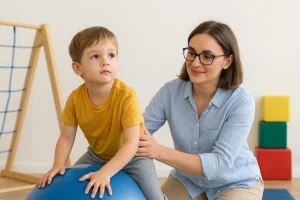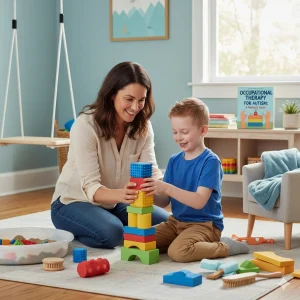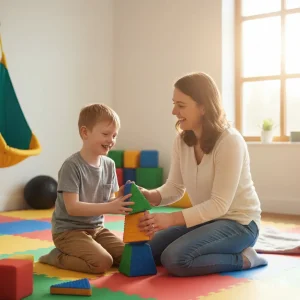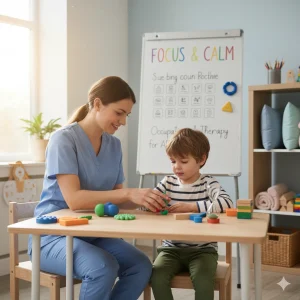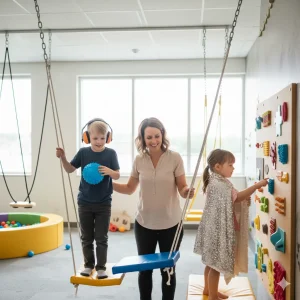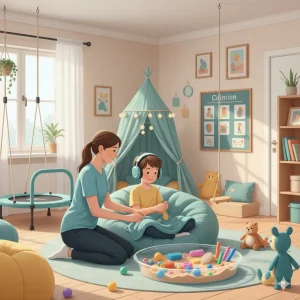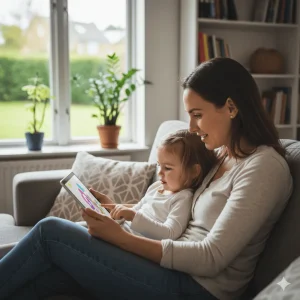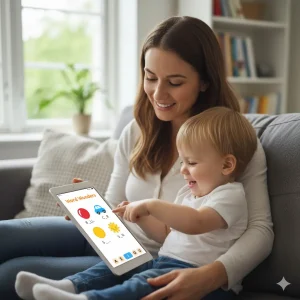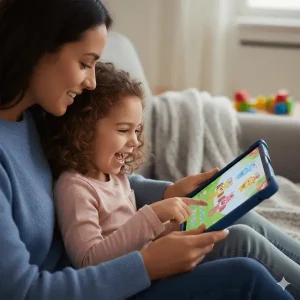What to Do If Your 3-Year-Old Isn’t Using Pronouns Correctly
By Rajini D
Last Updated: August 18, 2025
Have you noticed your 3-year-old saying things like “You want cookie” when they really mean “I want cookie”? Or maybe they call Dad “he” and Mom “him”—leaving you wondering if this pronoun mix-up is normal. 3-year-old pronoun reversal—also known as pronoun confusion—is one of the most common concerns parents bring up.
The good news is, most children go through a stage where pronoun reversal (mixing up I/you or he/she) happens, and it’s often just part of learning language. But because pronouns are a key speech milestone at age 3, parents naturally worry: “Should my child already be using pronouns correctly?” or “Does this mean my toddler has a speech delay?”
Free Speech Help for Kids
Concerned about speech delays? Book a free consultation with our expert speech therapist and get guidance tailored to your child’s needs.
When Do Toddlers Learn Pronouns?
One of the most common questions parents ask is: “When do toddlers learn pronouns?” Pronouns are a big step in speech development because they show your child is beginning to understand perspective—knowing the difference between I and you, or he and she.
Pronoun milestones age 3
- Around age 2–2.5 years: You’ll usually hear your toddler start using simple pronouns like I, me, my, and you. At this stage, it’s normal if they still get them wrong. For example, they may say “Me want toy” instead of “I want the toy.”
- By age 3: New pronouns begin to appear. Children typically add he, she, we, and they into their vocabulary. This shows they are starting to recognize other people’s roles and relationships in daily life.
- By age 4: Most children can use a wide range of pronouns correctly most of the time. They’re able to switch between I/you and he/she/they with less confusion.
Also read: Language Development in Kids: Key Stages, Tips & Challenges
Quick Pronoun Development Timeline
| Age | Typical Pronouns Learned | Example Speech |
|---|---|---|
| 2 years | I, me, my, you | “I play ball” / “Me want juice” |
| 3 years | he, she, we, they | “She is running” / “We go park” |
| 4 years | his, her, them, us | “That’s her toy” / “Give it to them” |
Is Pronoun Reversal Normal at Age 3?
If your toddler points to themselves and says “You want cookie” instead of “I want cookie”, you’re not alone. This mix-up, known as pronoun reversal, happens when children say “you” instead of “I” or confuse words like he and she. Many parents worry about this, often asking, “Is pronoun reversal normal at 3?”
Why Pronoun Reversal Happens
For young children, pronouns can be tricky because they change depending on who is speaking. Unlike words like ball or dog, pronouns don’t have a fixed object or picture to attach to. That makes them harder to grasp.
Some common reasons toddlers show I/you confusion include:
- Echolalia (repeating words): Toddlers often echo what they hear. If you say, “Do you want juice?”, they may copy back “You want juice” instead of “I want juice.”
- Perspective-taking challenges: Understanding that “I” means me and “you” means someone else requires social awareness, which is still developing at this age.
- Learning curve: At age 3, pronouns like I, you, he, she, they are just becoming part of everyday speech. Occasional mix-ups are part of typical development.
Read more: Understanding Echolalia: 10 Key Differences in Speech Disorders
Pronoun Reversal vs. Typical Development
Occasional mistakes with pronouns are normal at age 3. Most children figure it out with more practice, especially when parents and caregivers model correct usage in daily routines. For example:
- Child: “You want toy.”
- Parent: “Oh, you mean, I want the toy.”
This gentle correction helps toddlers learn the difference over time.
When to Watch for Red Flags
While pronoun confusion is common, there are times when it may signal a bigger challenge. Consider checking in with a speech-language pathologist if:
- Your child still uses “you” instead of “I” consistently after age 3.5–4 years.
- They rarely use pronouns at all.
- They show other speech or social delays (limited vocabulary, poor eye contact, or difficulty with back-and-forth conversations).
Bottom line: Pronoun reversal at age 3 is usually a normal part of speech development. With modeling, everyday practice, and time, most children outgrow it. If the mix-ups continue well past age 4, or if you notice other developmental concerns, early support from a professional can make a big difference.
Why Do Toddlers Mix Up He/She/They?
It’s very common for parents to notice their toddler saying “He is eating” when they mean “She is eating,” or mixing up they and we. These kinds of pronoun mistakes in toddlers can feel confusing for adults, but for children, it’s simply part of the learning process. If your little one is mixing up he and she, you’re not alone—it’s a stage most toddlers go through.
The Complexity of Language
Unlike nouns such as dog or ball, pronouns don’t have a clear object or picture attached to them. That makes them more abstract. Pronoun confusion happens because children are trying to figure out that words like he, she, they, and we change depending on who we are talking about.
Why Gender Pronouns Are Learned Later
Research shows that toddlers usually learn I, me, my, and you first (around age 2), and only later begin using he, she, we, and they (around age 3). This is because gender and group pronouns require a stronger understanding of relationships and social roles. For a toddler, it’s easier to talk about themselves (I/me) before accurately describing others (he/she/they).
The Role of Exposure and Modeling
The way toddlers hear language at home plays a big role in how quickly they master pronouns. If your child mostly hears sentences like “Mommy is cooking” instead of “She is cooking,” it may take them longer to use he and she correctly. Consistent modeling of pronouns in daily routines is one of the most effective ways to reduce confusion.
Example:
- Instead of saying, “Daddy’s playing,” try saying, “He is playing with the ball.”
- During group play, point out, “They are building a tower together.”
Building Understanding Through Comprehension
Sometimes, children may understand pronouns before they use them correctly. A toddler might respond correctly if you ask, “Where is she?”, but still mix up he and she in their own speech. This shows comprehension usually comes first, and expressive use follows with practice.
In short: If your toddler is mixing up he and she or struggling with they/we, it’s usually a sign that they’re still figuring out the complex rules of language. With more exposure, modeling, and natural conversation, most children sort it out by age 4.
Also read: Where Is It? Prepositions – Behind & In Front Of
How to Teach Pronouns to Toddlers at Home
If you’ve noticed your little one getting stuck on he, she, I, or you, don’t worry—there are plenty of fun and natural ways to help. You don’t need special tools or a classroom; with some simple strategies, you can easily teach pronouns to toddlers during everyday routines.
Use Modeling in Daily Routines
The best way to teach pronouns is through modeling. Narrate what’s happening using clear pronouns so your child hears them in context:
- “I am eating an apple. You are drinking juice.”
- “She is washing her hands. He is brushing his teeth.”
Repeating these short sentences throughout the day helps your toddler pick up the correct usage.
Read Books & Tell Stories
Children love stories, and books are a perfect way to introduce he, she, and they naturally. Choose picture books with clear characters and point them out:
- “Look, he is running.”
- “She is holding a teddy bear.”
- “They are playing together.”
This not only makes pronouns concrete but also keeps learning fun and engaging.
Use Visual Supports & Flashcards
Visuals help children connect the abstract idea of pronouns with something they can see. Try using flashcards or simple drawings:
- Show a picture of a boy and say, “He is eating.”
- Show a picture of a girl and say, “She is eating.”
Over time, your toddler will begin to copy you and use the correct pronoun.
Play-Based Games with Dolls & Toys
Play is the language of children, and it’s also a fantastic way to teach pronouns. During pretend play:
- Act out scenarios with dolls or action figures: “He is sleeping. She is jumping. They are playing together.”
- Use role-play: “I’ll be the mommy. You be the baby. What is she doing?”
These simple games to teach pronouns keep learning interactive and enjoyable.
Point Out Pronouns in Everyday Conversations
Everyday life is full of opportunities. At the park, you might say, “He is on the slide. She is on the swing. They are running together.” At home, you can model, “I am cooking. You are helping.” Consistent exposure makes pronouns part of your child’s natural speech.
Key Takeaway: Toddlers learn best when language feels natural and playful. By weaving in books, visuals, play, and daily modeling, you give your child multiple chances to practice pronouns without it feeling like “work.” With time and repetition, pronoun mix-ups usually fade away.
When Should I Be Concerned?
It’s natural for parents to wonder, “When should I be concerned about pronoun mix-ups?” After all, toddlers don’t always get grammar right, and mistakes are expected. But there are times when pronoun confusion may point to something more than just normal learning.
What’s Normal and What’s Not
- Normal range: At age 3, occasional mix-ups like saying “You want toy” instead of “I want toy” or switching he/she are still within the typical range. Most children sort these out by age 4.
- Possible concern: If your child consistently uses the wrong pronouns after 3.5–4 years, or avoids pronouns altogether, it could be a sign of a speech or language delay.
Does Pronoun Reversal Mean Autism?
Parents often ask, “Does pronoun reversal mean autism?” The short answer is: not always. Many toddlers without autism go through a phase of pronoun reversal. However, when pronoun mistakes occur alongside other challenges—such as limited vocabulary, lack of eye contact, echolalia (repeating phrases), or difficulties with back-and-forth conversation—it may be worth exploring whether autism spectrum disorder (ASD) is a factor.
It’s important to remember: pronoun mix-ups alone do not mean a child has autism. They are just one piece of the larger developmental picture.
When to Consult a Speech-Language Pathologist (SLP)
If your child is:
- Still struggling with basic pronouns past age 4
- Rarely using pronouns in speech
- Showing broader delays in language, social skills, or play
…then it’s a good idea to consult a speech-language pathologist (SLP). An SLP can assess your child’s overall communication skills, determine whether pronoun use is delayed, and suggest strategies or therapy activities tailored to your child’s needs.
The Benefits of Early Intervention
The good news is that early support makes a big difference. Research shows that children who receive help before age 5 often make faster progress in language and social skills. Even simple, parent-led strategies—like modeling pronouns at home or practicing through play—work even better when guided by an SLP.
Takeaway: Occasional pronoun mix-ups at age 3 are usually normal, but if they persist past 3.5–4 years or come with other developmental red flags, it’s wise to seek professional guidance. Early childhood intervention helps children build confidence and communication skills, giving them a strong foundation for preschool and beyond.
Speech Therapy Goals for Pronouns
If your child is still struggling with pronouns, a speech-language pathologist (SLP) may recommend therapy to support their progress. Parents often wonder what happens in therapy sessions and what the pronoun goals for toddlers speech therapy look like. The good news is that therapy is playful, engaging, and highly tailored to your child’s needs.
What SLPs Look For in an Assessment
During the initial evaluation, an SLP doesn’t just check if your child can say he, she, or I/you. They look at both:
- Pronoun comprehension vs. expression: Can your toddler understand pronouns when you say them (“Where is she?”)? Do they also use them correctly when speaking?
- Consistency of use: Do they mix up pronouns all the time, or only in certain situations?
- Overall communication skills: Vocabulary size, sentence length, and social interaction are also considered, since pronouns are just one piece of language development.
Common Therapy Goals for Pronouns
Every child’s goals are customized, but some typical pronoun targets in therapy include:
- Mastering I/you: Helping children switch roles so they know “I want” vs. “You want.”
- He/She accuracy: Practicing gender pronouns with clear pictures, dolls, or story characters.
- They/We introduction: Expanding to group pronouns once the basics are solid.
- Using pronouns in sentences: Moving beyond single words to short phrases like “She is running” or “They are eating.”
Parent Involvement in Practice
One of the strongest predictors of success is parent involvement. SLPs often give families simple activities to reinforce therapy goals at home:
- Modeling pronouns during daily routines (“I am washing. You are drying.”)
- Using picture books and asking, “What is he doing? What is she doing?”
- Playing turn-taking games with dolls or action figures to practice he, she, they.
- Encouraging your child to talk about their own actions using I/me/my.
When therapy goals are reinforced both in sessions and at home, children typically make faster progress and gain confidence in their speech.
Bottom line: In speech therapy, pronoun goals are not just about memorizing words. They focus on helping your child understand and use pronouns naturally in everyday situations. With the right mix of professional support and at-home practice, most toddlers quickly gain the skills they need to use pronouns correctly.
Conclusion
It’s normal for a 3-year-old to mix up pronouns like he, she, I, and you. Most toddlers figure this out with time, play, and gentle correction. You can help by reading stories, using flashcards, and modeling clear sentences in daily life. If pronoun confusion continues after age 3.5–4, or you notice other speech or social delays, it’s smart to check in with a speech therapist. Early support makes learning easier. Helpful tools like the BASICS App give parents fun, simple ways to practice pronouns at home and build stronger language skills.
Frequently Asked Questions:
1. When do toddlers usually start using pronouns?
Most toddlers begin saying pronouns like I, me, my, and you between 2 and 2.5 years old. At first, it’s normal if they use them incorrectly—for example, saying “Me want toy” instead of “I want toy.” By around age 3, children often start using he, she, we, and they. By age 4, most children can use a wide range of pronouns correctly in everyday speech.
2. Is it normal for a 3-year-old to mix up pronouns?
Yes, it is very common. Many 3-year-olds mix up pronouns such as I/you or he/she. This is often called pronoun reversal, and it usually happens because pronouns change depending on who is speaking. Occasional mistakes at this age are part of normal speech development. Most children figure it out with time, exposure, and gentle correction from adults.
3. Why does my toddler say “you” instead of “I”?
This is a classic example of I/you confusion in toddlers. Children often repeat the exact words they hear, which is called echolalia. So, if you ask your child, “Do you want juice?”, they might copy it back as “You want juice” instead of saying “I want juice.” Over time, as they understand perspective-taking (that I means themselves and you means the listener), they begin to use these words correctly.
4. How can I help my toddler learn pronouns at home?
The best way to teach pronouns to toddlers is through everyday activities. You can:
- Model sentences: “I am washing my hands. You are drying yours.”
- Read books and point to pictures: “She is running. He is eating.”
- Use flashcards with boys, girls, and groups.
- Play pretend games with dolls or toys and label actions: “He is sleeping. They are playing.”
The more natural and fun you make it, the quicker your child will learn.
5. At what age should a child use he and she correctly?
Children usually begin using he and she around age 3, but it’s very common for them to mix them up at first. By age 4, most children use gender pronouns correctly in everyday conversations. Keep in mind that each child develops at their own pace, so some may master these words a little earlier or later.
6. When should I be concerned about pronoun mix-ups?
Occasional pronoun mistakes at age 3 are normal. However, if your child:
- Still says “you” instead of “I” after age 3.5–4
- Rarely uses pronouns at all
- Has other signs of a speech or social delay (very small vocabulary, poor eye contact, trouble with back-and-forth conversation)
…then it’s a good idea to talk to a speech-language pathologist (SLP). They can check if your child’s pronoun use is part of typical development or if extra support would help.
7. Does pronoun reversal mean autism?
Not always. While pronoun reversal can sometimes be seen in children with autism, many toddlers without autism also go through this stage. If pronoun mistakes happen alongside other signs—like limited speech, repeating phrases without meaning, avoiding eye contact, or struggling with social interaction—then it may be worth checking with a professional. Pronoun mix-ups by themselves do not mean a child has autism.
8. What activities can I try to teach pronouns?
Fun, everyday activities work best for teaching pronouns:
- Role-play games: Pretend to be different people and switch roles (“I am the doctor. You are the patient.”).
- Story time: Point to characters and ask, “What is he doing? What is she holding?”
- Flashcards and visuals: Show a picture of a girl eating and say, “She is eating.”
- Real-life pointing: At the park, say, “He is on the slide. They are running.”
These activities to practice pronouns are simple, fun, and effective.
9. Can speech therapy help with pronoun confusion?
Yes. In speech therapy, children work on pronoun goals step by step. An SLP might start with mastering I/you, then move to he/she, and later introduce they/we. They use pictures, games, and role-play so learning feels like play. Parents are also given easy activities to practice at home. This teamwork between therapy and daily life usually helps children make faster progress.
10. Why do toddlers confuse he and she?
Pronouns like he and she are harder to learn because they don’t point to a specific object, like a toy or animal. Instead, they change depending on who we’re talking about. Toddlers also hear adults use names more often than pronouns (for example, “Daddy is cooking” instead of “He is cooking”). That means they may not get as much practice hearing gender pronouns in context. With more modeling, exposure, and practice, children usually stop confusing he and she by around age 4.
About the Author:
Rajini Darugupally
M.Sc., Speech-Language Pathologist (9+ years of experience)
Rajini is a passionate and dedicated Speech-Language Pathologist with over 9+ years of experience, specializing in both developmental speech and language disorders in children and rehabilitation in adults. Driven by a desire to empower each individual to find their voice, Rajini brings a wealth of experience and a warm, genuine approach to therapy. Currently, at Wellness Hub, she thrives in a team environment that values innovation, compassion, and achieving results for their clients.
Book your Free Consultation Today
Parent/Caregiver Info:
Client’s Details:
* Error Message
